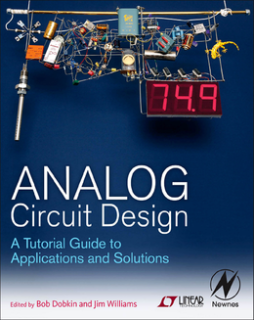
Additional Information
Book Details
Abstract
Analog circuit and system design today is more essential than ever before. With the growth of digital systems, wireless communications, complex industrial and automotive systems, designers are challenged to develop sophisticated analog solutions. This comprehensive source book of circuit design solutions will aid systems designers with elegant and practical design techniques that focus on common circuit design challenges. The book’s in-depth application examples provide insight into circuit design and application solutions that you can apply in today’s demanding designs.
- Covers the fundamentals of linear/analog circuit and system design to guide engineers with their design challenges
- Based on the Application Notes of Linear Technology, the foremost designer of high performance analog products, readers will gain practical insights into design techniques and practice
- Broad range of topics, including power management tutorials, switching regulator design, linear regulator design, data conversion, signal conditioning, and high frequency/RF design
- Contributors include the leading lights in analog design, Robert Dobkin, Jim Williams and Carl Nelson, among others
"This book is a great companion volume to Volume I with informative application notes and a full complement of reference designs. The chapters are not just every day application notes and reference designs, but give insights to problem-solving, design decision-making the thought process that goes along with a robust, successful design. That's why I love this book…This book is a keeper that needs to be on every designer's bookshelf, right next to Volume I." --EDN.com, March 2013
"Subtitled 'Immersion in the black art of analog design', this huge book has over 1,200 A4 pages of joy…you will learn something from every page…delightfully readable." --ElectronicsWeekly.com, April 2013
"…this is quite an extensive work with 1250 pages. A collection of "application notes"…[it will] help you understand and solve practical problems. Here interesting questions will be answered such as ‘Why is my phone ringing,’ but also highly complex power supply circuits." --Design and Elektronik, February 2013
"For analog designers or anyone who brushes against analog design issues…Analog Circuit Design: A Tutorial Guide to Applications and Solutions...is a great place to start. Each time I look through this book, I get new insight and understanding based on the knowledge, experience, challenges, and mysteries the authors and other contributors bring…books like this can help you get your job done faster and with fewer re-spins." --Planet Analog, January 2013
"This in-depth source book of circuit design solutions supplies engineers with practical design techniques that focus on common analog challenges. The full support package includes online resources such as data sheets, design notes and LTspice design simulation software tools from Linear Technology." --EETimes.com and others, December 2012
"The 932-page book compiles 41 of Linear Tech's applications and each app note has its own chapter. The book divides information into two sections; one that covers power management (19 app notes) and a second that covers data conversion, signal conditioning, and Highfrequency & RF (22 app notes)... Anyone who works with analog electronics--and those who hope to--should own a copy of this book." --Dev-Monkey.com
"This is a handsome book that I will happily find space for on my shelf. It is extremely good value for money and is, thank heavens, a prime example of why it will be some time before e-books have a real place in the publication of technology texts. There should be a place for this latest ANALOG Circuit Design in the hands of every novice, journeyman, and experienced analog designer." --En Genius.net
"In September, three months after a stroke ended Jim’s life, the book – what may be the only coffee table book for analog engineers – came out. What’s remarkable is how easy it is to get into, how much it makes you want to browse – like a traditional coffee-table book. As my friend Paul Rako, described Jim’s writing style, ‘He never tried to impress you with his math or his intellect. He didn't make things complicated so you would think he was smart. He made things look simple. That is why he was brilliant.’" --Electronic Design.com
